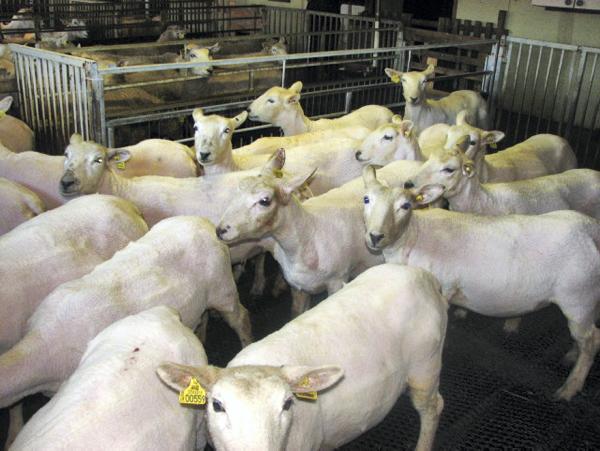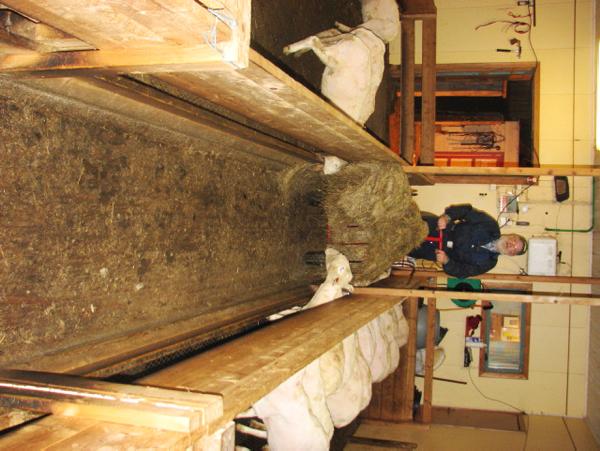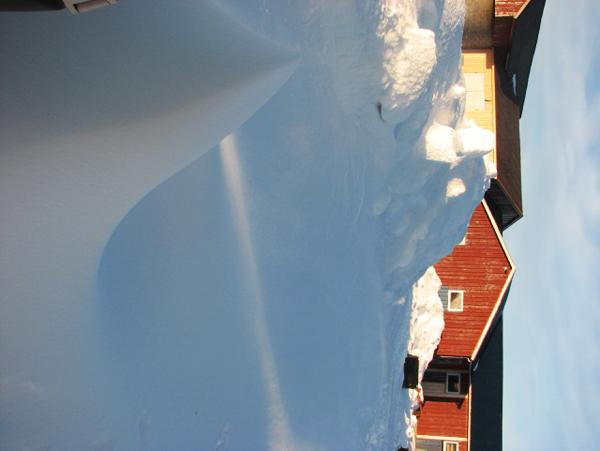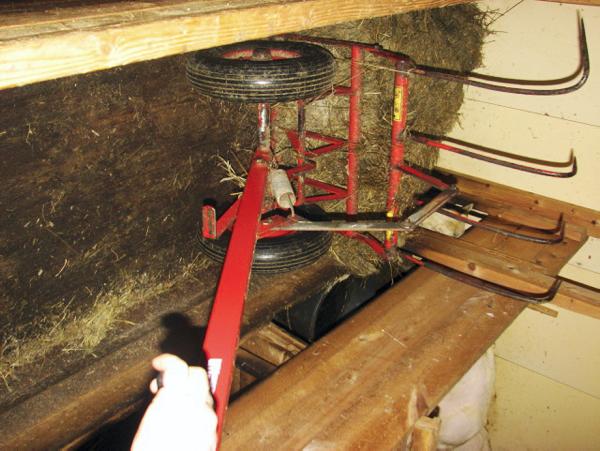For the last 20 years, I have travelled to the very northern region of Norway every spring and autumn to shear sheep. The trips generally last three to four weeks and I shear about 2,700 sheep for 21 or 22 farmers in the autumn and around 4,000 sheep in the spring.
Despite so many trips, it is still a big shock to the system and takes quite some time to get accustomed to the change in environment.
The change in temperature is the first thing that hits you. It’s not so bad when you step off the plane in Oslo, but it gets colder and colder as you head north.
Saying that, when I was over in November it wasn’t as cold as it usually is with temperatures on the coldest nights falling to about -18°C.
It’s generally colder in the dead of winter and spring and it’s not unusual for temperatures to fall in the coldest periods to -30°C.
The cold can generally be managed with extra clothes and taking precautions to protect yourself when outside.
But another aspect that is hard to get used to is the shortness of days. The northern region of Scandinavian countries has two full months in the winter when there is 24-hour darkness.
I haven’t been there in this extreme but it doesn’t make much odds as, when I was there in November, there was only about four to four and a half hours of daylight. As such, you are getting up when it was getting dark and saw no brightness all day.
This is where an interesting fact about snow comes into play. There can be snow on the ground for eight months of the year or even longer.
You would think this would be a major hindrance but the people in the area prefer when there is snow on the ground as it is the only thing that helps to bring a bit of light to the darkness.
Also, snow is central to a lot of the entertainment with skiing and snowboarding, etc., all big pastimes.
The area I shear in is in the very northern region, with some of the farms not far from the Russian border.
If you take the size of the northern territory, or Finnmark as it is known, it is about the same size as Denmark but has a population of about 60,000 compared to 6m to 7m people in Denmark.
There is one main road through this area and a network of minor roads leading from this with some areas very isolated.
Eight-month winter
Sheep farming is a common parttime activity for farmers in the area I work in. It is a very high-cost system with the majority of sheep housed for eight months of the year.
Housing for this long is hard to get your head around but I must say the farms are very well set up to cope with these difficult circumstances.
Sheep are housed mainly in insulated sheds that can be best described as having a very similar appearance to a house with a front door and windows.
The sheds are kept cool with extractors present to aid airflow if required. In some of the sheds I shore in, you would have to turn off the extractors to let the shed heat up at least a small bit so you could work in a pair of overalls.
It’s not unusual for there to be snow built up half-way the outside of the building with sheep housed very comfortably inside.
Small numbers are housed in barns that are not as well insulated and you’d certainly know about the cold when shearing in these sheds.
In a very small number of cases, some mountain type breeds of sheep are released outdoors during the day to an area beside sheds or maintained and supplemented outdoors with shelter.
The fact that sheep are housed for so long and most sheds are so well insulated is a big part of twice yearly shearing.
Farmers tell me that the main reason is to house more sheep in a given area but it also allows the temperature to be regulated easier than if sheep had a full fleece.
Sheep are generally shorn shortly after housing in October/November or in March/early April with ewes lambing in May.
In general, the conditions for shearing are fine. You definitely wouldn’t be wearing a singlet (t-shirt without sleeves) but if you’re shearing in an insulated shed you might get away with just pants and a jumper.
It sure can get hairy, though, if shearing in a barn with no insulation and in this case you would need overall pants and maybe even a jacket which does make it a bit harder to shear.
Wool is given great attention and is packed into long cylinder like packs.
Sheep are generally in a very clean condition for shearing with practically all sheep housed on slats due to the cost of straw.
The main breed is the Norwegian White which can be described as a long, deep bodied sheep with good conformation.
Sheep scour very little and I come across very little sheep with dirty tail ends. This is despite not being allowed to tail dock (or castrate) without veterinary involvement.
The other main breed of sheep is a small, wild mountain type sheep but these are not kept regularly in intensive enterprises in this area due to their lower output potential.
Good stockmanship
I find that sheep are looked after very well with an emphasis on maintaining sheep in good body condition while housed.
This is so that concentrates do not have to be introduced and supplementary feed can be minimised.
Excellent quality haylage or silage is the main diet during the housing period. Some people have asked me how it is possible to get away with feeding low levels of concentrates and how farmers manage to save such a high quality feed when there is up to eight months of snow on the ground.
While there is 20 to 24 hours of darkness in the winter, there is also 20 to 24 hours of daylight during the summer. I am told that during this period grass growth is excellent with ample opportunities to save high quality winter feed.
Feed is saved in exactly the same way as here with McHale balers a popular sight on a number of farms.
Most feed is saved dry so that the moisture will not freeze in the winter. On a few farms, though, farmers prefer to make wetter silage and in these cases there are shredders (similar to those for chopping wood) that chop the frozen silage which can then be fed in blocks as it thaws.
The high cost nature of housing means space is used to its maximum. Feeding passages are kept to a minimum width and ewes are fed twice daily to demand to prevent fodder accumulating and spoiling or pulled into pens.
Ewes in late pregnancy may be fed even more frequently to improve intake and performance.
In all my years, I have seen very little foot problems (footrot and CODD) which is helped by slatted flooring and a very strict culling policy for repeat offenders.
Poor breeders or problem ewes are culled very quickly and farmers check sheep again when shearing to make sure there are no problems in udders, feet, mouth, etc., since breeding.
All ewes are also culled at six years of age irrespective of how good of breeders they are. The focus is on making every sheep that is housed over the winter try to pay for their keep with replacement ewe lambs also bred on practically every farm.
The breeds used are prolific and it is not uncommon for a significant percentage of ewes to give birth to three, four or even five lambs. Extra lambs are usually reared artificially.
Grazing season
Sheep are released outdoors in June after snow thaws and lambs get hardy. The terrain of the area is a mix of good quality lowland and hill/mountain grazing.
Sheep are sent to the hills for grazing during the summer and remain there for about three months. These areas are not overly stocked and ewes and lambs generally thrive very well.
Ewe lambs selected as replacements are given preferential treatment and grown as much as possible before the breeding season.
Lambs are slaughtered from weaning to housing with very little lambs finished indoors.
I should mention that all sheep are also shorn on the line post slaughter and I have done a few stints shearing in factories. It is strange shearing dead sheep but it happens in a conveyor belt type system where a number of shearers work on different areas of lambs and you quickly get used to it.
Predator risk
Wildlife predators are a huge concern for farmers. This is the reason lambs are retained indoors or around the yard until they become hardy.
The main predators are wolves, lynx (larger tiger-like cat) and bears. All of these are protected species and farmers can get up to 10 years in jail for shooting these animals.
As you can imagine, it is quite a contentious issue for farmers. Only trained hunters can shoot these animals to maintain their population at a given level.
Farmers receive compensation for sheep killed by protected species but attacks are often so severe that it takes a few years to build numbers back up.
Standard of living
Norwegian sheep farming is a laborious and high cost system but there are favourable incentives and high levels of government support for those in difficult farming areas.
The farmers I dealt with this year received about 48 Krone per kg carcase (approximately €6/kg) with all lambs sold through the factory.
Government support works to incentivise production (reason high litter sizes are targeted) and is paid in the north at about 60KOR per kilo carcase (€7.50/kg).
Lambs are paid to a maximum of 20kg carcaseweight, meaning a 19kg carcase returns about €250. It seems high but remember this includes all their support payments and costs are very high.
Factories operate an EUROP payment scale and penalise to dis-incentivise overweight lambs by cutting every kilo produced by 3.5KOR or about 50c/kg once carcaseweight exceeds 20kg.
People living in these areas have become accustomed to the way of life and are also involved in fishing, mining or service jobs.
Snow is taken as a given with all cars switching to snow tyres and not travelling without an ‘emergency’ pack in case cars get lost in snow storms or go off-road.
Those operating snow ploughs and sand gritters, for example, actually make quite a good living from snow with a focus on keeping public amenities open.
Kids who often get a day off school here when there is a heavy snowfall would be disappointed to know that schools are practically never closed due to snow in Norway.
I have also been in Norway during some very scary snowstorms but I cannot ever remember the electricity going.
It has to be pointed out that many people find it quite hard to function properly when the day length starts to verge on the side of very few daylight or dark hours.
There can also be quite high levels of depression in isolated areas, especially in times of snow storms where people could end up isolated from neighbours for a few days.
The people are very like the Irish and are very welcoming. During the time I spend there, I live in with the person I am shearing for and move from house to house.
I am treated like one of the family with offence taken if I don’t make myself at home.
While the shearing is challenging, it is an experience that I have come to enjoy and now take it as part of my normal year to travel twice a year to Norway.
Norway’s sheep industry
Agriculture is a small contributor to Norway’s GDP of $499.8bn. It accounts for 2.2% of GDP with industry accounting for 45.1% and services 52.7%. Sheep numbers have held relatively stable. Depending on the source, census numbers show just over 900,000 sheep over one year of age on farms in 2012. The number of flockowners with sheep one year and over has fallen by over 25% in the last decade to over 14,000 flockowners. However, the national flock has been maintained by the average number of sheep over one year per holding rising from approximately 50 in 2003 to an estimated 63 per holding in 2013.






 This is a subscriber-only article
This is a subscriber-only article

















SHARING OPTIONS: